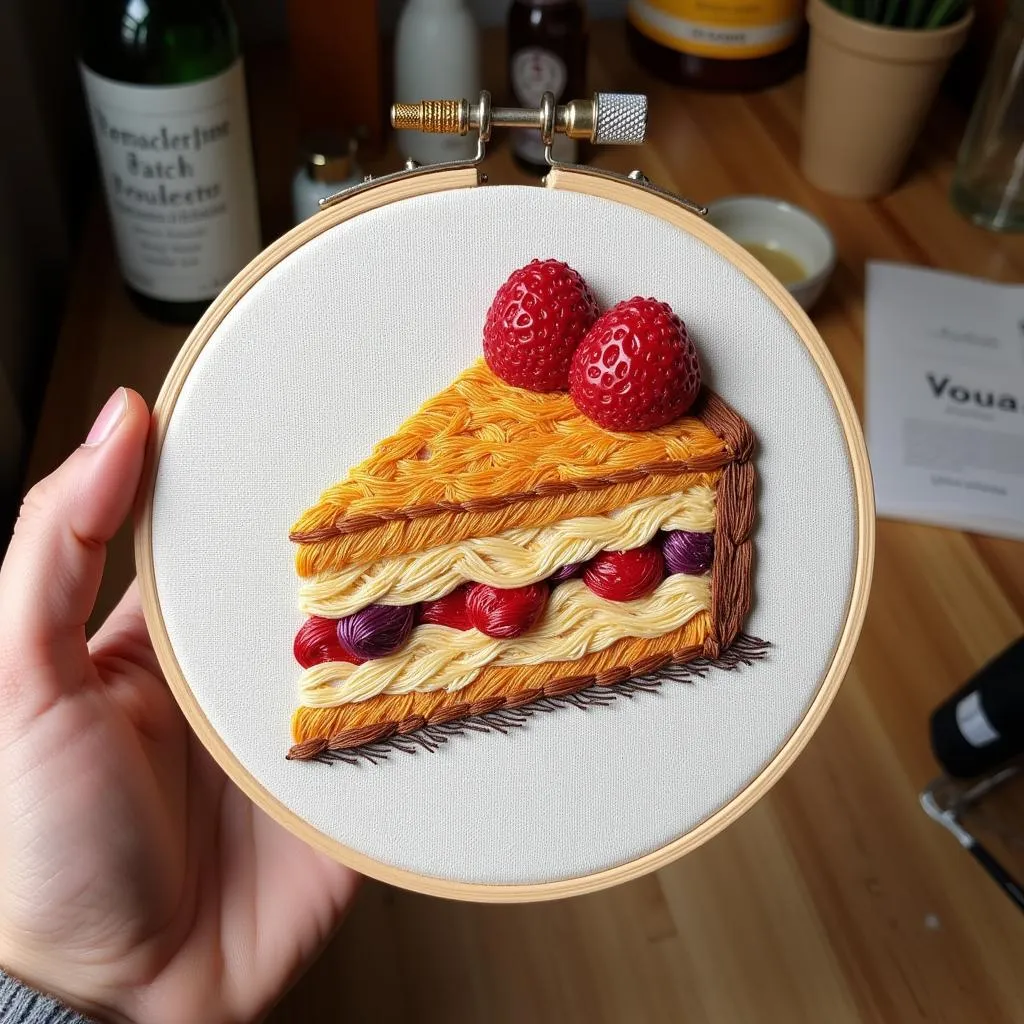Food Embroidery, a unique blend of culinary arts and needlework, transforms ordinary fabrics into edible masterpieces. This captivating craft allows you to express your love for food in a whole new way, whether you’re stitching a simple strawberry or a complex croquembouche.
From Plate to Pattern: Exploring Food Embroidery Designs
 Food embroidery patterns
Food embroidery patterns
Food embroidery encompasses a wide array of designs, catering to all skill levels and culinary preferences. Beginners can start with basic shapes like fruits, vegetables, and eggs, while more experienced embroiderers can tackle intricate pastries, multi-layered cakes, or even entire charcuterie boards. The key is to choose designs that resonate with your personal style and culinary passions.
Essential Tools for Stitching Delicious Creations
Like any craft, food embroidery requires a few essential tools to get started:
- Embroidery hoop: Keeps the fabric taut for even stitching.
- Embroidery needles: Choose needles with sharp points for piercing fabric easily.
- Embroidery floss: Available in countless colors to match any food item.
- Water-soluble fabric: Acts as the base for your embroidery and dissolves completely in water, leaving behind a stunning freestanding piece.
- Scissors: For trimming excess thread and fabric.
Bringing Your Food Embroidery to Life: A Step-by-Step Guide
Ready to embark on your food embroidery journey? Here’s a simplified guide to get you started:
- Select your design: Choose a pattern that aligns with your skill level and interests.
- Transfer the pattern: Trace the design onto the water-soluble fabric using a water-soluble marker.
- Hoop your fabric: Secure the fabric tightly within the embroidery hoop to prevent puckering.
- Thread your needle: Choose a floss color that matches your design and thread the needle.
- Start stitching: Following the pattern lines, carefully stitch your design onto the fabric, using various embroidery stitches for texture and dimension.
- Dissolve the fabric: Once your embroidery is complete, soak the fabric in warm water until it dissolves, leaving behind your stunning creation.
 Completed food embroidery project
Completed food embroidery project
Beyond the Basics: Tips for Embroidering Realistic Food
- Utilize a variety of stitches: Experiment with different embroidery stitches like satin stitch, back stitch, and French knots to create texture and dimension, mimicking the various textures found in food.
- Incorporate beads and sequins: Add a touch of sparkle and realism by incorporating beads and sequins into your designs, representing sugar sprinkles, salt crystals, or even bubbles in a beverage.
- Play with color gradients: Use multiple shades of floss to create realistic color gradients, such as the gradual ripening of a tomato or the browning on a freshly baked cookie.
Food Embroidery: A Feast for the Eyes and Imagination
“Food embroidery goes beyond simple needlework; it’s about capturing the essence of food – its vibrant colors, intricate textures, and even the emotions it evokes.” – Emily Carter, renowned embroidery artist
From whimsical cupcakes to intricate sushi platters, food embroidery offers endless creative possibilities. It allows you to explore your love for food in a tangible and artistic way, transforming simple threads into edible works of art. So, gather your supplies, choose your favorite culinary inspiration, and let your needle create a feast for the eyes!
Frequently Asked Questions about Food Embroidery
1. What type of fabric is used for food embroidery?
Water-soluble fabric, also known as stabilizer, is primarily used for food embroidery as it dissolves completely in water, leaving behind the stitched design.
2. Is food embroidery difficult to learn?
Like any new craft, food embroidery requires practice. However, starting with basic designs and stitches can make the learning process enjoyable and rewarding.
3. What are some creative ways to display food embroidery?
Food embroidery pieces can be displayed in embroidery hoops, framed as artwork, or even incorporated into greeting cards and scrapbook layouts.
4. Can I wash my food embroidery?
It’s not recommended to wash food embroidery pieces as they are delicate and the threads may bleed or fray.
5. Where can I find food embroidery patterns and inspiration?
Numerous online platforms, craft books, and embroidery communities offer a plethora of food embroidery patterns and inspiring designs to explore.
Need help with your food embroidery project?
Contact us at Phone Number: 02437655121, Email: minacones@gmail.com. Or visit us at 3PGH+8R9, ĐT70A, thôn Trung, Bắc Từ Liêm, Hà Nội, Việt Nam. We have a 24/7 customer service team.